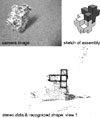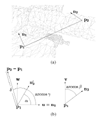Object Recognition and Scene
Analysis
From a universal perspective, it is the goal of machine vision to determine
for an artificial agent where in the environment things are and what they are.
Answering these two questions constitutes a scene interpretation in the generic
sense.
A satisfying answer to what things are, that is, the result of object
recognition, can pass various types of information, depending on the application
context. The answer may range from assigning a discrete object-class label, to
estimating several continuous object parameters, to inferring how to grasp or
even use an object. Moreover, relations between several objects are often
relevant for understanding a situation. A scene may be constrained to feature
only specific objects from an a priori known set, arbitrary objects from certain
abstract classes, or may even contain completely unknown objects.
In the general setting, the problem of computing scene interpretations within
any reasonable amount of time using current hardware is far from being solved.
Only for certain applications and rather constrained worlds do we currently have
satisfying solutions. Scene interpretation, therefore, remains the ultimate
long-term goal of basic research in computer vision.
 |
A Probabilistic Hypothesize-and-Test
Paradigm
Model-based object recognition or, more
generally, scene interpretation may be conceptualized as a two-part
process: one that generates a sequence of hypotheses on object
identities and poses, the other that evaluates them based on the
object models. Viewed as an optimization problem, the former is
concerned with the search sequence, the latter with the objective
function. |
Full article |
|
 |
Pose-Invariant Object
Recognition
Robust scene interpretation by means of
machine vision is a key factor in various new applications in
robotics. Part of this problem is the efficient recognition and
classification of previously known three-dimensional (3D) shapes in
arbitrary scenes. So far, heavily constrained conditions have been
utilized, or otherwise solutions have not been achieved in real
time. |
Full article |
|
 |
Analyzing Scenes on a Supporting
Plane
Suppose we constrain objects from a known set to
stand in certain `upright' poses on a supporting plane, for
instance, chairs and tables on the floor, or glasses and bottles on
a table. The orientation of such planes is often known, as for a
mobile robot in flat terrain. |
Full article |
|